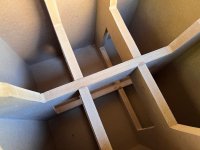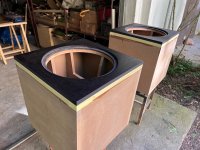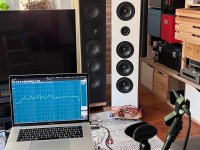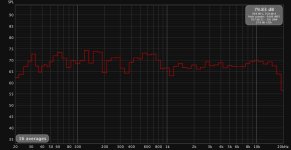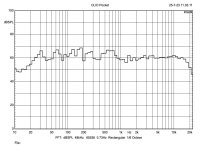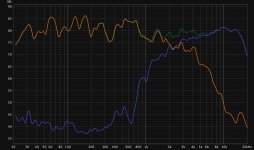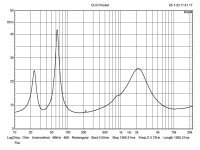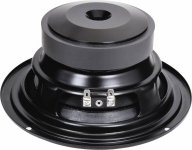Hi, I'm quite keen on this project. Does anyone have any idea how these would compare to kef 104.2 or 107.2s sound quality wise?
Using with a solic state amp listening to accoustic, folk, rock kind of music.
I am of course biased, but I think you will love them. 😎
But where are you in Oz? I see an Australian flag.
Yes, I know this measuring technique. I will present soon.
Somewhere in the middle of next week I will take the speakers to a large space, nicely enclosed by a wall of trees. There I will try to collect measurement data different from those in the room. Although my room is well prepared for work and listening to music, it is still a room with speakers, so it does both.
Joe, I'm looking at you and trying to keep up 🙂
I'm currently working on two boxes of 15" subwoofers (Dayton Audio RSS390HF-4) in closed enclosures.
They will be powered by miniDSP Flex Digital, via a separate DAC + Amp. Thanks to this, just like in your case, ULDs will be relieved from work in the lowest registers.
Somewhere in the middle of next week I will take the speakers to a large space, nicely enclosed by a wall of trees. There I will try to collect measurement data different from those in the room. Although my room is well prepared for work and listening to music, it is still a room with speakers, so it does both.
The Subs only contribute below 30Hz and 24dB cut-off rate and tweaking the phase for minimum interference - the Subs are largely inaudible until they cut in with appropriate source material.
Joe, I'm looking at you and trying to keep up 🙂
I'm currently working on two boxes of 15" subwoofers (Dayton Audio RSS390HF-4) in closed enclosures.
They will be powered by miniDSP Flex Digital, via a separate DAC + Amp. Thanks to this, just like in your case, ULDs will be relieved from work in the lowest registers.
Attachments
Current measurements.
RTA 1/6 oct. REW and Clio Pocket.
SPL 1/6 oct of the whole and separately the mid-bass + tweeter section.
Laptop only for a commemorative photo moved so close to the microphone 🙂
RTA 1/6 oct. REW and Clio Pocket.
SPL 1/6 oct of the whole and separately the mid-bass + tweeter section.
Laptop only for a commemorative photo moved so close to the microphone 🙂
Attachments
Hi Joe, I'm based in Melbourne.I am of course biased, but I think you will love them. 😎
But where are you in Oz? I see an Australian flag.
I have found someone whom I can get the parts from. Do you have any idea how much it would cost to get the panels CNC cut and any recommendations around Melbourne?
Regarding the STX speaker itself.
It has a steel basket, which is quite a built-up back. It is possible that a trace of such a construction can be seen on the impedance diagram around 220Hz. I don't know. It may also be the lack of a soft gasket under all speakers. They will be added when they come back from the paint shop.
This jump in characteristics is yet to be explored.
And one more thing. The transducers have already played a bit and I should measure them as far as I can. I have the feeling that they do not have the effectiveness declared by the manufacturer. Suspiciously, I have to dampen the tweeter. Now it's a 3R9/33R resistor ladder.
It has a steel basket, which is quite a built-up back. It is possible that a trace of such a construction can be seen on the impedance diagram around 220Hz. I don't know. It may also be the lack of a soft gasket under all speakers. They will be added when they come back from the paint shop.
This jump in characteristics is yet to be explored.
And one more thing. The transducers have already played a bit and I should measure them as far as I can. I have the feeling that they do not have the effectiveness declared by the manufacturer. Suspiciously, I have to dampen the tweeter. Now it's a 3R9/33R resistor ladder.
Attachments
Hi Joe, I'm based in Melbourne.
I have found someone whom I can get the parts from. Do you have any idea how much it would cost to get the panels CNC cut and any recommendations around Melbourne?
Not much help, I am in Sydney and I have a guy who sorts stuff like out for me after I have done the 2D CAD drawings.
Does anyone have any idea how these would compare to kef 104.2 or 107.2s sound quality wise?
Sscov:
Apologies in advance for what will likely be a rather boring discourse: I owned a pair of Kef 105.4 loudspeakers many years ago; they were my first pair of audiophile grade speakers. I don't have any experience with Kef's 104.2 or 107.2 speakers but, if Kef has continued to manufacture speakers with a common "house sound", I have a decent idea what they sound like. In the era when I owned my 105.4s, speakers were said to have a "West coast sound," "East coast sound" or "British sound." The West coast sound was less refined but bright, punchy and wild, with a lot of impact, and was recommended for jazz and rock. East coast sound was more more refined, smoother in tone and typically less efficient, and better suited for folk and classical music. British sound was similar to East coast sound but had a somewhat muddy and constrained mid-range. My Kef 105.4s had the British sound. I enjoyed them for many years until deciding I wanted more "air" and mid-range detail.
By the foregoing standard, the Elsinores lean towards an East coast sound, though their impact with jazz and rock material is excellent. They also happen to be very efficient. The Elsinores, in my opinion, represent a vast improvement over my old Kef 105.4s. Hell, the Elsinores represent a vast improvement over the Mirage M-1s, which replaced my 105.4s, and (as previously mentioned) are clearly superior to the Egglestonworks Andras they replaced in my main system.
The Elsinores are keepers.
Regards,
Scott
In spite of the room, these plots are quite close.I tried to get the tuning of the kit as close as possible to the original Elsinores.
Very encouraging information. Thanks Scott!Sscov:
Apologies in advance for what will likely be a rather boring discourse: I owned a pair of Kef 105.4 loudspeakers many years ago; they were my first pair of audiophile grade speakers. I don't have any experience with Kef's 104.2 or 107.2 speakers but, if Kef has continued to manufacture speakers with a common "house sound", I have a decent idea what they sound like. In the era when I owned my 105.4s, speakers were said to have a "West coast sound," "East coast sound" or "British sound." The West coast sound was less refined but bright, punchy and wild, with a lot of impact, and was recommended for jazz and rock. East coast sound was more more refined, smoother in tone and typically less efficient, and better suited for folk and classical music. British sound was similar to East coast sound but had a somewhat muddy and constrained mid-range. My Kef 105.4s had the British sound. I enjoyed them for many years until deciding I wanted more "air" and mid-range detail.
By the foregoing standard, the Elsinores lean towards an East coast sound, though their impact with jazz and rock material is excellent. They also happen to be very efficient. The Elsinores, in my opinion, represent a vast improvement over my old Kef 105.4s. Hell, the Elsinores represent a vast improvement over the Mirage M-1s, which replaced my 105.4s, and (as previously mentioned) are clearly superior to the Egglestonworks Andras they replaced in my main system.
The Elsinores are keepers.
Regards,
Scott
Or maybe - Shadow of ElsinoreMaybe we shall call them Elsinore light. 😉
Hi Scott, How would you compare the bass response of the 2. Those kefs I guess are using 2 10inch woofers compared 6in drivers used in Elsinores.The Elsinores, in my opinion, represent a vast improvement over my old Kef 105.4s. Hell, the Elsinores represent a vast improvement over the Mirage M-1s, which replaced my 105.4s, and (as previously mentioned) are clearly superior to the Egglestonworks Andras they replaced in my main system.
Also what drivers did you use in your built? SBAccoustics of Purify of something else. Just trying to think if the choice of drivers could have a big impact on SQ in Elsinores.
These questions since I'm on the verge of building these vs buying some secondhand above mentioned kefs.
Sscov:
How would I compare the bass response of which two? I owned the Kef 105.4s for about 8 years, but they were gone from my system perhaps 33 years ago. I remember them fondly but my recollection is largely based on the comparisons I remember when replacing them with Mirage M-1s. The M-1s were sold about 22 years ago when I purchased the Egglestonworks Andras. I remember very clearly how the Andras bettered the M-1s because I spent a few weeks doing direct comparisons before the M-1s were sold. And then, about 5 years ago, the Elsinores replaced the Andras. I had dozens of people over to help me evaluate the Andras and Elsinores (that was a real treat!). But the Elsinores vs. the 105.4s? That's an impossible comparison for me because those two speaker systems are separated by too much time and vastly different systems.
Here's what I'd say: each successive change in loudspeakers represented, for me, a massive upgrade. The Kefs were impressive speakers for their time, my young (and perhaps impressionable) ears and my sensibilities. But they were compromised in that they had a somewhat constrained (i.e., dull) midrange and the treble never sounded real. Yes, they sounded good. But there was no air between the performers and the spatial cues were decent but not great. The M-1s were a big improvement over the 105.4s. The M-1s brought air, spatial cues and a more neutral presentation into the mix. They created a bigger and more realistic soundstage. I liked the M-1s a lot. The Andras, which cost something like 4 or 5 times the M-1s, were at least twice as good -- the Andras were effortless in their presentation and just disappeared. If you closed your eyes the sense of real performances right in front of you was tantalizingly close. I loved the Andras. And the Elsinores are better still (and not by a small margin). My Elsinores are magical.
Here's the thing: Everyone who builds audio components wants to believe that what they built is excellent and well worth the time and money. That's probably a truth that broadly applies to everything we buy -- no one wants to think they bought stupidly and no one wants to admit it if they did -- but when you spend a lot of time constructing the thing you're evaluating your investment and the stakes seem higher. So take what I say with a huge grain of salt: at no time in my progression from one loudspeaker system to another did the quality of music in my stereo decline. Each time there was a big step forward. There were three giant leaps between my 105.4s and my Elsinores.
So please stop comparing the Kefs to the Elsinores. Honestly, no disrespect intended here but if you want to compare the Elsinores to something, find a much better speaker than the Kefs.
Finally: SBAcoustics.
Sorry for the rant.
Regards,
Scott
How would I compare the bass response of which two? I owned the Kef 105.4s for about 8 years, but they were gone from my system perhaps 33 years ago. I remember them fondly but my recollection is largely based on the comparisons I remember when replacing them with Mirage M-1s. The M-1s were sold about 22 years ago when I purchased the Egglestonworks Andras. I remember very clearly how the Andras bettered the M-1s because I spent a few weeks doing direct comparisons before the M-1s were sold. And then, about 5 years ago, the Elsinores replaced the Andras. I had dozens of people over to help me evaluate the Andras and Elsinores (that was a real treat!). But the Elsinores vs. the 105.4s? That's an impossible comparison for me because those two speaker systems are separated by too much time and vastly different systems.
Here's what I'd say: each successive change in loudspeakers represented, for me, a massive upgrade. The Kefs were impressive speakers for their time, my young (and perhaps impressionable) ears and my sensibilities. But they were compromised in that they had a somewhat constrained (i.e., dull) midrange and the treble never sounded real. Yes, they sounded good. But there was no air between the performers and the spatial cues were decent but not great. The M-1s were a big improvement over the 105.4s. The M-1s brought air, spatial cues and a more neutral presentation into the mix. They created a bigger and more realistic soundstage. I liked the M-1s a lot. The Andras, which cost something like 4 or 5 times the M-1s, were at least twice as good -- the Andras were effortless in their presentation and just disappeared. If you closed your eyes the sense of real performances right in front of you was tantalizingly close. I loved the Andras. And the Elsinores are better still (and not by a small margin). My Elsinores are magical.
Here's the thing: Everyone who builds audio components wants to believe that what they built is excellent and well worth the time and money. That's probably a truth that broadly applies to everything we buy -- no one wants to think they bought stupidly and no one wants to admit it if they did -- but when you spend a lot of time constructing the thing you're evaluating your investment and the stakes seem higher. So take what I say with a huge grain of salt: at no time in my progression from one loudspeaker system to another did the quality of music in my stereo decline. Each time there was a big step forward. There were three giant leaps between my 105.4s and my Elsinores.
So please stop comparing the Kefs to the Elsinores. Honestly, no disrespect intended here but if you want to compare the Elsinores to something, find a much better speaker than the Kefs.
Finally: SBAcoustics.
Sorry for the rant.
Regards,
Scott
Whew! Not messing about in the end.
For a DIY speaker, there is a lot of relatively unseen 21st century technology built into them. They are a modern speaker.
.
For a DIY speaker, there is a lot of relatively unseen 21st century technology built into them. They are a modern speaker.
.
Great! I'm looking at the drawings on Joe's website and I guess it's a typo (should be 146mm as well ) in the attached pic as all the 4 woofers are the same?

Yesterday went to my friend Keshav's house, he lives about twenty minutes away. He has always said that my Elsinores in my room (been here many times), always sounded better than he did in his room, could I come to his house and see if I could make suggestion?
His room has 2.7m ceilings. The speakers were across a 4m wall and the room was 5m deep. He had some diffusers on the side walls. Before I left I made two suggestions that he later that day implemented. I said to space the speakers that 2.15m (tweeter to tweeter) apart wider if possible and even 100mm each way could make a difference. His listening distance is 2.5m. I then explained that his diffusers (home-made) on the side walls should get closer to the speaker in such a way that they would treat the 1st reflections of the side walls.
He then sent me the following text message:
"Moved the speakers 200mm further apart [100mm each way] and placed the diffusers in a better place. Improved the sound quite a bit. Closer to the sound of your system."
[added]
"Tweeter to tweeter is exactly... 2500mm. Yup. Quite an improvement., Thanks."
So he ended up with a 2.5m triangulation.
The reason I am mentioning it here is that it looks wide compared to the listening position. The improvement he heard did not surprise, not one bit. Most people listen to the speakers too close together and you end up with an elongated triangle. But many speakers don't benefit from being wider, but the Elsinores are designed for being listened to when you have perfect triangulation and the absolute minimum distance to be 2m, so 2.5m is just fine.
So if you Elsinore owners can be mindful of that?
My own room is about 7m wide, but is narrow to one side. The listening area is 4m deep and the ceilings are 2.6m - and I listen to a 2500m triangulation and the speakers toed in, so that I listen to roughly 15° off axis and from Tweeters to the listeners we are exactly at 2500mm triangulation. Often people are surprised because the speakers look wider. But in fact they are not.
If it is possible, try tweak in light of the above and report back here.
EDIT:
PS: Both Keshav's speakers and my own, the tweeter to the back wall distance is 1.2m which means for the size of the room it looks well into the room. This is not the back of the speaker to the wall, rather from the centre of the front panel to the back wall behind the system is 1.2m and that is also something to look at.
His room has 2.7m ceilings. The speakers were across a 4m wall and the room was 5m deep. He had some diffusers on the side walls. Before I left I made two suggestions that he later that day implemented. I said to space the speakers that 2.15m (tweeter to tweeter) apart wider if possible and even 100mm each way could make a difference. His listening distance is 2.5m. I then explained that his diffusers (home-made) on the side walls should get closer to the speaker in such a way that they would treat the 1st reflections of the side walls.
He then sent me the following text message:
"Moved the speakers 200mm further apart [100mm each way] and placed the diffusers in a better place. Improved the sound quite a bit. Closer to the sound of your system."
[added]
"Tweeter to tweeter is exactly... 2500mm. Yup. Quite an improvement., Thanks."
So he ended up with a 2.5m triangulation.
The reason I am mentioning it here is that it looks wide compared to the listening position. The improvement he heard did not surprise, not one bit. Most people listen to the speakers too close together and you end up with an elongated triangle. But many speakers don't benefit from being wider, but the Elsinores are designed for being listened to when you have perfect triangulation and the absolute minimum distance to be 2m, so 2.5m is just fine.
So if you Elsinore owners can be mindful of that?
My own room is about 7m wide, but is narrow to one side. The listening area is 4m deep and the ceilings are 2.6m - and I listen to a 2500m triangulation and the speakers toed in, so that I listen to roughly 15° off axis and from Tweeters to the listeners we are exactly at 2500mm triangulation. Often people are surprised because the speakers look wider. But in fact they are not.
If it is possible, try tweak in light of the above and report back here.
EDIT:
PS: Both Keshav's speakers and my own, the tweeter to the back wall distance is 1.2m which means for the size of the room it looks well into the room. This is not the back of the speaker to the wall, rather from the centre of the front panel to the back wall behind the system is 1.2m and that is also something to look at.
Hi - Can someone let me know what size spade terminals and what size hex head screws to use with SB17NRXC35-8 drivers?
speaker terminals (should be different sizes for + and -) - https://www.wagneronline.com.au/spade-terminals-male-female/connectors/cables-connectors/4309/fl/
screws - https://www.ebay.com.au/itm/155552316294
speaker terminals (should be different sizes for + and -) - https://www.wagneronline.com.au/spade-terminals-male-female/connectors/cables-connectors/4309/fl/
screws - https://www.ebay.com.au/itm/155552316294
maybe a rookie question...
The diameter of SB17NRXC35-8 drivers measures to be 171mm (as given by the pic in the previous post too) but the plans specify a diameter of 174mm. Is there a particular technical reason behind this? I don't think an extra 3mm is an error tolerance or something (perhaps 1mm would have been enough for that)?
The diameter of SB17NRXC35-8 drivers measures to be 171mm (as given by the pic in the previous post too) but the plans specify a diameter of 174mm. Is there a particular technical reason behind this? I don't think an extra 3mm is an error tolerance or something (perhaps 1mm would have been enough for that)?
- Home
- Loudspeakers
- Multi-Way
- The "Elsinore Project" Thread

